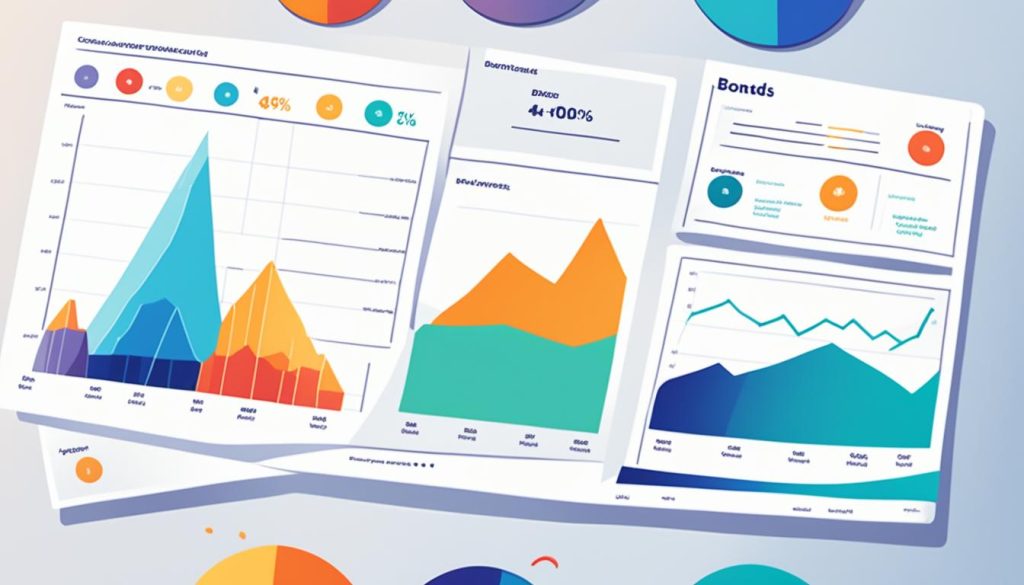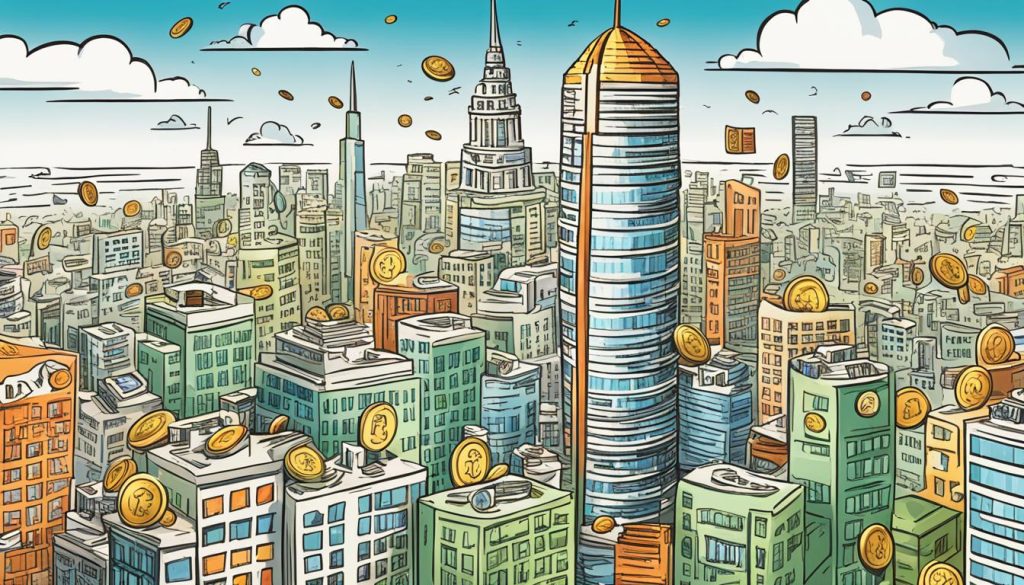In the world of investing, high-yield bonds, or junk bonds, play a big role. They offer higher returns than regular bonds. Over the last 20 years, they’ve grown a lot, giving investors many choices from different places and industries1.
Knowing how the global high-yield bond market works is key. It helps you make better investment choices. By understanding this market, you can find new opportunities and reduce risks. This can make your investment strategy more successful1.
Key Takeaways
- High-yield bonds, also known as junk bonds or speculative-grade bonds, offer higher yields than investment-grade bonds but carry greater risk.
- The high-yield bond market has experienced significant growth over the past two decades, providing investors access to a diverse range of issuers.
- Understanding the dynamics of the global high-yield bond market, including its size, credit quality, and technical factors, can help investors navigate this landscape.
- Navigating the high-yield bond market requires a thorough understanding of the risks, including credit risk, interest-rate risk, and market risk.
- Investors should consider the role of high-yield bonds in their investment portfolio and how they can potentially enhance their overall investment strategy.
Understanding the Global High-Yield Bond Market
The global economy is facing challenges, and the high-yield bonds market has changed a lot. Since 2021, the value of high-yield bonds has dropped by 18%. This change is due to some companies moving from high-yield to investment-grade status. Also, defaults and early bond buybacks have played a role2.
Market Size and Dynamics
Looking closer, we see that the high-yield bond market has a mix of ratings. Over a third of the market is BB-rated bonds, while B-rated bonds are the biggest group at 55%. Less than 9% of the market includes CCC-rated and lower bonds2.
Ratings Breakdown and Credit Quality
Bonds rated above BB+ by Standard & Poor’s and Fitch, or Ba1 by Moody’s, are seen as investment grade. Those rated below are non-investment grade2. Most C-rated and lower bonds have a high risk of default2. High-yield bonds are more volatile and have less liquidity than investment-grade bonds2.
The big three ratings agencies, Moody’s, Standard & Poor’s, and Fitch, watch the high-yield bond market closely. Their credit quality ratings are key for investors to balance risk and potential rewards2.
The high-yield bond market is vital and changing with the global economy. Knowing its size, composition, and how ratings and credit quality affect it helps investors make better choices3.
The Rising Role of Private Credit
The high-yield bond market is facing stiff competition from the booming private credit market. Private credit has taken over some debt that used to go to public markets. Now, private credit makes up about 21% of U.S. leveraged finance and 34% in Europe, while high-yield bonds account for around 40%4.
In the world of leveraged buyouts, private credit is becoming a key player. Yet, the public and private debt markets co-exist. Companies like the competition and stricter terms from private credit, which can help keep default rates low4.
Private Credit Displacement and Co-existence
The demand for private credit has soared, reaching about $1.5 trillion at the start of 2024, up from $1 trillion in 2020. Experts predict it will hit $2.8 trillion by 20284.
Direct lending, a type of private credit, offers better returns and less volatility than other options since the financial crisis. In tough economic times, it brought in 11.6% returns, outpacing leveraged loans and high-yield bonds. During the COVID-19 pandemic, it even managed a 1.1% loss, less than other types of debt4.
Private credit has shown it can handle economic downturns better than public debt. It’s seen as a chance to provide junior capital and hybrid solutions in today’s high-interest rates. Offering credit to top-notch companies and rescue financing in tough times are also promising areas4.
Investors are turning to private credit for its potential for higher returns than traditional bonds. Private credit doesn’t move with the stock and bond markets as much, which can make portfolios less volatile and more profitable. It also offers a premium for its illiquidity, making it a unique investment option4.
The rise of private credit is driven by banks pulling back on loans to riskier borrowers after the GFC and private equity firms choosing private credit for buyout deals over traditional debt5.
As the high-yield market has dropped by nearly 25% since mid-2021, the private credit market has grown significantly. This shift towards higher-quality bonds has boosted private credit‘s appeal5.
Today, a mix of ultra-high quality, broad credit, and speculative credit seems wise for managing risk and diversifying credit exposure5.
“Private credit has demonstrated historically lower loss rates relative to public credit over time.”
Technical Tailwinds and Spreads
The outlook for high-yield bonds looks good, with a smaller market size making them more valuable for investors6. Investors find the yields on high-yield bonds appealing, especially if interest rates go down. Many high-yield bonds are trading below face value, which means their prices could go up as they get closer to maturity6.
Favorable Technical Outlook
Credit spreads in the high-yield bond market are tight, but investors should watch for risks like geopolitical issues or economic downturns6. The global high-yield bond market has shrunk by 18% since 2021, making these bonds more scarce and valuable6. This scarcity could keep supporting high-yield bonds as investors look for good yields.
Private credit has also changed the high-yield bond market, making up 21% of US leveraged finance and 34% in Europe67. This shift might help high-yield bonds stay attractive as investors search for opportunities.
In Europe, maturing bonds and buybacks have balanced new issues since 2022, supporting high-yield bonds6. The global index shows a drop in BB-rated bonds in 2022-23, but an uptick since early 202467. This could mean a change in the credit quality of high-yield bonds.
But, the credit quality of high-yield bonds is still a worry. Only 15% of the least creditworthy US high-yield bonds got refinanced since 2022, unlike the 30-35% for better-rated ones67. Investors should keep an eye on credit quality and refinancing trends to spot risks and chances.
“The technical outlook for the high-yield bond asset class remains favorable, with a shrinking market size creating a scarcity value for investors.”
Navigating the high-yield bonds Landscape
Investing in high-yield bonds needs a smart plan to handle risks and possible rewards8. As the market changes, investors should watch out for risks, especially from rising interest rates8. It’s key to check credit quality to avoid bad bonds and find good ones in the lower-rated group.
Being active in investing can help you make the most of high-yield bond yields8. Keep an eye on credit quality, how easy it is to sell bonds, and how they react to interest rates. This way, you can build a portfolio that stands strong against market changes89.
It’s important to spread out your investments in high-yield bonds to balance risk and reward10. Mix different types of bonds with various credit ratings and sectors to reduce risks10. Also, stay alert to changes in interest rates and credit spreads. Be ready to change your investment plan if needed.

A smart and active way to invest in high-yield bonds can lead to good income and risk management8. By understanding the high-yield bond market, investors can make their portfolios more stable and possibly increase their returns810.
Idiosyncratic Risks and Active Management
In the high-yield bond market, risks specific to individual companies have grown more common11. These risks, known as idiosyncratic risks, make up most of the uncertainty in stock prices over time11. They come from the company’s management decisions on things like financial policies and investment strategies11.
Spreads in high-yield bonds show how important it is to actively manage these risks11. By choosing credits carefully, investors can lower the risk of defaults, especially in lower-quality bonds11. Diversifying your investments can also help reduce these risks11.
Dispersion in Spreads across Ratings
High-yield bonds face more risks from individual companies, with top borrowers refinancing 30-35% of their debt since 202211. Meanwhile, the least creditworthy borrowers have only refinanced 15% of their debt11. This shows the need for a proactive approach to managing high-yield bonds. Careful analysis can help spot and avoid risks from lower-quality issuers12.
Managing high-yield bonds actively is key to dealing with the risks and spread variations.
| Idiosyncratic Risk Types | Examples |
|---|---|
| Business Risk | Damage and repair expenses of oil pipelines for energy companies11 |
| Financial Risk | Dependence on charismatic leaders like Steve Jobs at Apple11 |
| Operational Risk | Decreased distributions to investors and share price declines due to damaged pipelines for companies like Kinder Morgan, Inc. (KMI) or Enbridge, Inc. (ENB)11 |
| Strategic Risk | Stock price tied to the performance of the crypto market for CoinBase (COIN)11 |
| Legal or Regulatory Risk | Potential changes in government policies or regulations affecting a specific industry or company11 |
Managing high-yield bonds well requires deep credit research12. By understanding the unique risks of each issuer, investors can make smart choices. This approach can help them benefit from high-yield bonds’ potential while managing risks13. High-yield bonds offer strong total return for long-term investors11. But, being careful and selective is key to success13.
high-yield bonds: Income Opportunities in a Low-Yield Environment
High-yield bonds are a great choice for investors in today’s low-yield market. They offer a yield to worst of about 5.7% in the US and 4% in Europe. This is similar to the US’s yield over the past three years and a bit higher in Europe. High-yield bonds have higher yields, making them appealing for those looking for income. This is especially true when other fixed-income assets have low yields14.
High-yield bonds, or junk bonds, are from companies at higher risk but offer higher returns. They can be a good choice for investors who do their homework14. To invest in these bonds, you can use mutual funds, closed-end funds, or exchange-traded funds. Look for bonds from well-known companies that are just going through a tough time.
| Asset Class | Yield-to-Worst | Duration |
|---|---|---|
| High Yield Bonds | 8.0% | 4.5 years |
| U.S. Treasuries | 4.0% | 6.3 years |
| Investment-Grade Corporates | 5.0% | 7.2 years |
The table shows that high-yield bonds have a much higher yield-to-worst than U.S. Treasuries and investment-grade corporate bonds. They also have a shorter duration. This makes them a good choice for investors looking for more income in a low-yield market15.

Remember, the performance of high-yield bonds is linked to the stock market. Economic conditions also play a role. So, it’s crucial to do your research and diversify your portfolio when investing in high-yield bonds14.
Addressing Common Myths about High-Yield Bonds
Many investors have wrong ideas about high-yield bonds. They think these bonds are very risky because they offer higher interest rates. But, the truth is, the default rate for these bonds is actually quite low. In the US and Europe, it’s been around 4.36% and 3.49% over the last 20 years16. By choosing the right bonds, investors can lower this risk, even when the economy is tough.
Some also believe that high-yield bonds move with stocks, which means they don’t spread out risk well. However, they actually move less in sync with stocks, about 0.8 over the last decade16. Also, they’re not as affected by rising interest rates as other bonds, because they offer higher returns16.
| Metric | High-Yield Bonds | Investment-Grade Bonds |
|---|---|---|
| Default Rates (US) | 4.36%16 | 0.10% |
| Default Rates (Europe) | 3.49%16 | 0.07% |
| Correlation with Equities | 0.816 | 0.3 |
| Yield Advantage | 5.6%16 | 3.7%16 |
By clearing up these myths, investors can better understand the real risks and benefits of high-yield bonds. This knowledge helps them make smarter choices and could improve their investment results161718.
Conclusion
High-yield bonds are a great choice for investors looking for good income and diversification19. They offer a chance to grow your money and spread out your investments. By learning about the global high-yield bond market, you can make smart choices that fit your financial goals and how much risk you can take.
19 High-yield bonds are less volatile than stocks but still give you the potential for big returns20. Adding them to a portfolio with only Treasury bonds has made it more stable and increased profits over the last 20 years19. They also don’t move much with interest rates, making them a good choice for diversifying your investments.
20 Since 1996, high-yield bonds have given an average 9.0% annual income and have only had three years with losses19. They are a stable investment even when rules change. By knowing how high-yield bonds work and their benefits, you can use them to improve your investment strategy and manage risk better.
FAQ
What are high-yield bonds?
High-yield bonds, also known as junk bonds or speculative-grade bonds, offer higher yields. They carry more risk than investment-grade bonds.
How has the global high-yield bond market performed in recent years?
The global high-yield bond market has seen ups and downs. The par value outstanding fell by 18% since 2021’s end. This shows some issuers moved to investment-grade, there were defaults, and bonds were bought back early.
How does the high-yield bond market compare to the private credit market?
The private credit market has grown, taking some debt away from the public markets, especially in leveraged buyouts. Yet, the public and private debt markets co-exist. Corporate borrowers like the competition, which can lead to stricter credit conditions in private credit.
What is the technical outlook for the high-yield bond asset class?
The outlook for high-yield bonds is positive, with a smaller market size making them more valuable for investors. Investors find the yields attractive outside of a recession, especially if interest rates go down.
What are the risks and considerations for investing in high-yield bonds?
Investing in high-yield bonds requires a careful approach to handle risks and potential rewards. Investors should watch for risks from monetary tightening and analyze credit fundamentals deeply.
How have high-yield bonds performed in the current low-yield environment?
In the low-yield environment, high-yield bonds offer good income chances for investors. They provide a yield to worst of about 5.7% in the US and 4% in Europe. These yields are similar to the past three years in the US and a bit higher in Europe.
What are some common myths about high-yield bonds?
Despite being seen as high-risk, high-yield bonds have a low default rate of 4.36% in the US and 3.49% in Europe over 20 years. They have a correlation of 0.8 with global equities, offering diversification. They’re also less sensitive to rising interest rates due to their high yields.
Source Links
- Bond Market Outlook: Improving Returns | Morgan Stanley
- High-Yield Bond: Definition, Types, and How to Invest
- Understanding High Yield Bonds | PIMCO
- Outlook: Private Credit | Morgan Stanley
- Is the growth in private credit cannibalizing the high yield market?
- Why the squeeze in high yield bonds is both good and bad
- Why the squeeze in high yield bonds is both good and bad
- Navigating Dynamic High Yield Markets
- How to Navigate the Ever-Changing Bond Landscape: The Barbell
- Understanding High Yield Bonds | PIMCO
- Idiosyncratic Risk: Definition, Types, Examples, Ways To Minimize
- High Yield Bonds | Alcentra
- H046414_0920 USO.indd
- Is It a Good Time to Consider High-Yield Bonds?
- T. Rowe Price Personal Investor – The Case for a Strategic Allocation to High Yield Bonds
- Should You Consider High-yield Municipal Bonds?
- Video: June 26 Webinar Replay – Not All High Yield is Junk
- Rethinking the role of bonds | BlackRock
- Microsoft Word – A-case-for-high-yield-bonds_final _Australian_.docx

